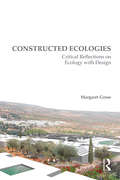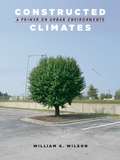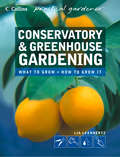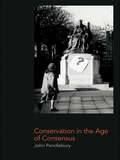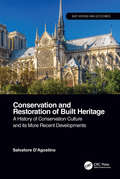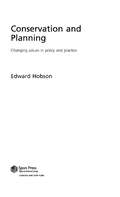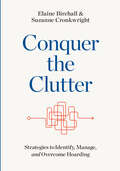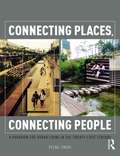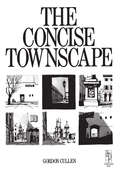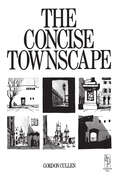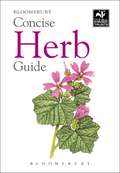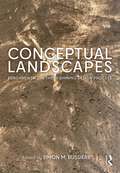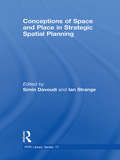- Table View
- List View
Constructed Ecologies: Critical Reflections on Ecology with Design
by Margaret GroseToday, designers are shifting the practice of landscape architecture towards the need for a more complex understanding of ecological science. Constructed Ecologies presents ecology as critical theory for design, and provides major ideas for design that are supported with solid and imaginative science. In the questioning narrative of Constructed Ecologies, the author discards many old and tired theories in landscape architecture. With detailed documentation, she casts off the savannah theory, critiques the search for universals, reveals the needed role of designers in large-scale agriculture, abandons the overlay technique of McHarg, and introduces the ecological and urban health urgency of public night lighting. Margaret Grose presents wide-ranging new approaches and shows the importance of learning from science for design, of going beyond assumptions, of working in multiple rather than single issues, of disrupting linear design thinking, and of dealing with data. This book is written with a clear voice by an ecologist and landscape architect who has led design students into loving ecological science for the support it gives design.
Constructed Ecologies: Critical Reflections on Ecology with Design
by Margaret GroseToday, designers are shifting the practice of landscape architecture towards the need for a more complex understanding of ecological science. Constructed Ecologies presents ecology as critical theory for design, and provides major ideas for design that are supported with solid and imaginative science. In the questioning narrative of Constructed Ecologies, the author discards many old and tired theories in landscape architecture. With detailed documentation, she casts off the savannah theory, critiques the search for universals, reveals the needed role of designers in large-scale agriculture, abandons the overlay technique of McHarg, and introduces the ecological and urban health urgency of public night lighting. Margaret Grose presents wide-ranging new approaches and shows the importance of learning from science for design, of going beyond assumptions, of working in multiple rather than single issues, of disrupting linear design thinking, and of dealing with data. This book is written with a clear voice by an ecologist and landscape architect who has led design students into loving ecological science for the support it gives design.
Constructed Climates: A Primer on Urban Environments
by William G. WilsonAs our world becomes increasingly urbanized, an understanding of the context, mechanisms, and consequences of city and suburban environments becomes more critical. Without a sense of what open spaces such as parks and gardens contribute, it’s difficult to argue for their creation and maintenance: in the face of schools needing resources, roads and sewers needing maintenance, and people suffering at the hands of others, why should cities and counties spend scarce dollars planting trees and preserving parks? In Constructed Climates, ecologist William G. Wilson demonstrates the value of urban green. Focusing specifically on the role of vegetation and trees, Wilson shows the costs and benefits reaped from urban open spaces, from cooler temperatures to better quality ground water—and why it all matters. While Constructed Climates is a work of science, it does not ignore the social component. Wilson looks at low-income areas that have poor vegetation, and shows how enhancing these areas through the planting of community gardens and trees can alleviate social ills. This book will be essential reading for environmentalists and anyone making decisions for the nature and well-being of our cities and citizens.
Constructed Climates: A Primer on Urban Environments
by William G. WilsonAs our world becomes increasingly urbanized, an understanding of the context, mechanisms, and consequences of city and suburban environments becomes more critical. Without a sense of what open spaces such as parks and gardens contribute, it’s difficult to argue for their creation and maintenance: in the face of schools needing resources, roads and sewers needing maintenance, and people suffering at the hands of others, why should cities and counties spend scarce dollars planting trees and preserving parks? In Constructed Climates, ecologist William G. Wilson demonstrates the value of urban green. Focusing specifically on the role of vegetation and trees, Wilson shows the costs and benefits reaped from urban open spaces, from cooler temperatures to better quality ground water—and why it all matters. While Constructed Climates is a work of science, it does not ignore the social component. Wilson looks at low-income areas that have poor vegetation, and shows how enhancing these areas through the planting of community gardens and trees can alleviate social ills. This book will be essential reading for environmentalists and anyone making decisions for the nature and well-being of our cities and citizens.
Constructed Climates: A Primer on Urban Environments
by William G. WilsonAs our world becomes increasingly urbanized, an understanding of the context, mechanisms, and consequences of city and suburban environments becomes more critical. Without a sense of what open spaces such as parks and gardens contribute, it’s difficult to argue for their creation and maintenance: in the face of schools needing resources, roads and sewers needing maintenance, and people suffering at the hands of others, why should cities and counties spend scarce dollars planting trees and preserving parks? In Constructed Climates, ecologist William G. Wilson demonstrates the value of urban green. Focusing specifically on the role of vegetation and trees, Wilson shows the costs and benefits reaped from urban open spaces, from cooler temperatures to better quality ground water—and why it all matters. While Constructed Climates is a work of science, it does not ignore the social component. Wilson looks at low-income areas that have poor vegetation, and shows how enhancing these areas through the planting of community gardens and trees can alleviate social ills. This book will be essential reading for environmentalists and anyone making decisions for the nature and well-being of our cities and citizens.
Conservatory and Greenhouse Gardening (Collins Practical Gardener)
by Lia LeendertzWhether it's a small citrus plant or a large vine, conservatory plants are more popular than ever. Collins Practical Gardener Conservatory & Greenhouse Gardening is bursting with practical advice and step-by-step instructions covering everything from choosing and planning a structure to filling it full of plants and keeping them thriving.
Conservation in the Age of Consensus
by John PendleburyThis new text on the subject of conservation in the built environment provides a unique holistic view on the understanding of the practice of conservation connecting it with wider societal and political forces. UK practice is used as a means, along with international examples, for bringing together a real understanding of practice with a social science analysis of the issues. The author introduces ideas about the meanings and values attached to historic environments and how that translates into public policies of conservation.
Conservation in the Age of Consensus
by John PendleburyThis new text on the subject of conservation in the built environment provides a unique holistic view on the understanding of the practice of conservation connecting it with wider societal and political forces. UK practice is used as a means, along with international examples, for bringing together a real understanding of practice with a social science analysis of the issues. The author introduces ideas about the meanings and values attached to historic environments and how that translates into public policies of conservation.
Conservation and Restoration of Built Heritage: A History of Conservation Culture and its More Recent Developments (Built Heritage and Geotechnics)
by Salvatore D'AgostinoThe word conservation, when used in the context of the preservation of built heritage, implies an intrinsically complex concept that evolved over time, since it has been influenced by the perception of history throughout time. This volume emphasises why an understanding of the cultural evolution of the conservation approach must be considered a prerequisite for architects and engineers if they are to cooperate in full harmony with historic-artistic culture for the preservation of global built heritage. In particular, the volume highlights how, during the second half of the last century, the preservation process also involved engineering – the science of making practical applications of knowledge – which, for a long time, made an uncritical use of techniques and materials and devised interventions on historical heritage that were heavily invasive. The volume also devotes special attention to the problems related to seismic risk, to which Italy, Greece and Portugal are particularly prone. Problems that emerge during the crisis and reconstruction phases are dealt with in detail, as is scheduled maintenance, as this latter approach always constitutes an improvement in the performance of the monument and is the most appropriate tool for the conservation of the built heritage. Finally, the volume collects examples of building restoration with case studies of many outstanding monuments. The work will appeal to professionals and academics in the broader fields of civil engineering (both geotechnical and structural engineering), architecture, art history, the history of architecture, restoration and cultural heritage management. This book will: Provide a critical reading of the history of conservation; Discuss materials and techniques of ancient architecture; Cover seismic vulnerability and preservation of the historic integrity of the monument; Advocate an approach based on programmed maintenance; Feature numerous case histories, including St Mark’s Basilica in Venice and the complex restoration of the cathedral of Notre-Dame in Paris.
Conservation and Restoration of Built Heritage: A History of Conservation Culture and its More Recent Developments (Built Heritage and Geotechnics)
by Salvatore D'AgostinoThe word conservation, when used in the context of the preservation of built heritage, implies an intrinsically complex concept that evolved over time, since it has been influenced by the perception of history throughout time. This volume emphasises why an understanding of the cultural evolution of the conservation approach must be considered a prerequisite for architects and engineers if they are to cooperate in full harmony with historic-artistic culture for the preservation of global built heritage. In particular, the volume highlights how, during the second half of the last century, the preservation process also involved engineering – the science of making practical applications of knowledge – which, for a long time, made an uncritical use of techniques and materials and devised interventions on historical heritage that were heavily invasive. The volume also devotes special attention to the problems related to seismic risk, to which Italy, Greece and Portugal are particularly prone. Problems that emerge during the crisis and reconstruction phases are dealt with in detail, as is scheduled maintenance, as this latter approach always constitutes an improvement in the performance of the monument and is the most appropriate tool for the conservation of the built heritage. Finally, the volume collects examples of building restoration with case studies of many outstanding monuments. The work will appeal to professionals and academics in the broader fields of civil engineering (both geotechnical and structural engineering), architecture, art history, the history of architecture, restoration and cultural heritage management. This book will: Provide a critical reading of the history of conservation; Discuss materials and techniques of ancient architecture; Cover seismic vulnerability and preservation of the historic integrity of the monument; Advocate an approach based on programmed maintenance; Feature numerous case histories, including St Mark’s Basilica in Venice and the complex restoration of the cathedral of Notre-Dame in Paris.
Conservation and Planning: Changing Values in Policy and Practice
by Edward HobsonConserving historic buildings continues to excite and inflame opinion. The means of protecting such buildings and areas are well established but frequently suffer a lack of wider understanding. Conservation and Planning takes a detailed look at the way these processes have evolved and their use today by policy makers and local decision makers.This book presents original research into how national and local decision-makers construct and implement conservation of the built environment. The findings in this book challenge many of the assumptions supporting conservation.
Conservation and Planning: Changing Values in Policy and Practice
by Edward HobsonConserving historic buildings continues to excite and inflame opinion. The means of protecting such buildings and areas are well established but frequently suffer a lack of wider understanding. Conservation and Planning takes a detailed look at the way these processes have evolved and their use today by policy makers and local decision makers.This book presents original research into how national and local decision-makers construct and implement conservation of the built environment. The findings in this book challenge many of the assumptions supporting conservation.
Conquer the Clutter: Strategies to Identify, Manage, and Overcome Hoarding
by Elaine Birchall Suzanne CronkwrightWhy does Cliff, a successful lawyer who regularly wins landmark cases, step over two-foot piles of paper whenever he opens his front door? Why do Joan and Paul ask Children's Services to take their three children instead of decluttering their home? Why does Lucinda feel intense pressure to hold onto her family's heirlooms even though she has no room for them? They have hoarding disorder, which an estimated 2% to 6% of the adult population worldwide experience.Conquer the Clutter offers hope to anyone affected by hoarding. Real-life vignettes, combined with easy-to-use assessment and intervention tools, support those who hoard—and those who care about them. Written by Elaine Birchall, a social worker dedicated to helping people declutter and achieve long-term control over their belongings, the book• provides an overview of hoarding, defining what it is—and is not• explains the difference between clutter and hoarding • describes different types of hoarding in detail, including impulse shopping, "closet" hoarding, and animal hoarding• debunks myths about hoarding and hoarders • explores the effects that hoarding has on relationships, on work, and on physical and financial health• presents a practical, step-by-step plan of action for decluttering• contains dedicated advice from individuals who have successfully overcome their hoarding disorderThe most comprehensive work about hoarding on the market, Conquer the Clutter discusses special populations who are not often singled out, such as the disabled and the elderly, and includes numerous worksheets to assist individuals in determining the scope of their hoarding disorder and tackling the problem.
Conquer the Clutter: Strategies to Identify, Manage, and Overcome Hoarding
by Elaine Birchall Suzanne CronkwrightWhy does Cliff, a successful lawyer who regularly wins landmark cases, step over two-foot piles of paper whenever he opens his front door? Why do Joan and Paul ask Children's Services to take their three children instead of decluttering their home? Why does Lucinda feel intense pressure to hold onto her family's heirlooms even though she has no room for them? They have hoarding disorder, which an estimated 2% to 6% of the adult population worldwide experience.Conquer the Clutter offers hope to anyone affected by hoarding. Real-life vignettes, combined with easy-to-use assessment and intervention tools, support those who hoard—and those who care about them. Written by Elaine Birchall, a social worker dedicated to helping people declutter and achieve long-term control over their belongings, the book• provides an overview of hoarding, defining what it is—and is not• explains the difference between clutter and hoarding • describes different types of hoarding in detail, including impulse shopping, "closet" hoarding, and animal hoarding• debunks myths about hoarding and hoarders • explores the effects that hoarding has on relationships, on work, and on physical and financial health• presents a practical, step-by-step plan of action for decluttering• contains dedicated advice from individuals who have successfully overcome their hoarding disorderThe most comprehensive work about hoarding on the market, Conquer the Clutter discusses special populations who are not often singled out, such as the disabled and the elderly, and includes numerous worksheets to assist individuals in determining the scope of their hoarding disorder and tackling the problem.
Connecting Places, Connecting People: A Paradigm for Urban Living in the 21st Century
by Reena TiwariWhat is a better community? How can we reconfigure places and transport networks to create environmentally friendly, economically sound, and socially just communities? How can we meet the challenges of growing pollution, depleting fossil fuels, rising gasoline prices, traffic congestion, traffic fatalities, increased prevalence of obesity, and lack of social inclusion? The era of car-based planning has led to the disconnection of people and place in developed countries, and is rapidly doing so in the developing countries of the Global South. The unfolding mega-trend in technological innovation, while adding new patterns of future living and mobility in the cities, will question the relevance of face-to-face connections. What will be the ‘glue’ that holds communities together in the future? To build better communities and to build better cities, we need to reconnect people and places. Connecting Places, Connecting People offers a new paradigm for place making by reordering urban planning principles from prioritizing movement of vehicles to focusing on places and the people who live in them. Numerous case studies, including many from developing countries in the Global South, illustrate how this can be realized or fallen short of in practical terms. Importantly, citizens need to be engaged in policy development, to connect with each other and with government agencies. To measure the connectivity attributes of places and the success of strategies to meet the needs, an Audit Tool is offered for a continual quantitative and qualitative evaluation.
Connecting Places, Connecting People: A Paradigm for Urban Living in the 21st Century
by Reena TiwariWhat is a better community? How can we reconfigure places and transport networks to create environmentally friendly, economically sound, and socially just communities? How can we meet the challenges of growing pollution, depleting fossil fuels, rising gasoline prices, traffic congestion, traffic fatalities, increased prevalence of obesity, and lack of social inclusion? The era of car-based planning has led to the disconnection of people and place in developed countries, and is rapidly doing so in the developing countries of the Global South. The unfolding mega-trend in technological innovation, while adding new patterns of future living and mobility in the cities, will question the relevance of face-to-face connections. What will be the ‘glue’ that holds communities together in the future? To build better communities and to build better cities, we need to reconnect people and places. Connecting Places, Connecting People offers a new paradigm for place making by reordering urban planning principles from prioritizing movement of vehicles to focusing on places and the people who live in them. Numerous case studies, including many from developing countries in the Global South, illustrate how this can be realized or fallen short of in practical terms. Importantly, citizens need to be engaged in policy development, to connect with each other and with government agencies. To measure the connectivity attributes of places and the success of strategies to meet the needs, an Audit Tool is offered for a continual quantitative and qualitative evaluation.
Concise Townscape
by Gordon CullenThis book pioneered the concept of townscape. 'Townscape' is the art of giving visual coherence and organization to the jumble of buildings, streets and space that make up the urban environment. It has been a major influence on architects, planners and others concerned with what cities should look like.
Concise Townscape
by Gordon CullenThis book pioneered the concept of townscape. 'Townscape' is the art of giving visual coherence and organization to the jumble of buildings, streets and space that make up the urban environment. It has been a major influence on architects, planners and others concerned with what cities should look like.
Concise Herb Guide
by BloomsburyThis beautifully illustrated mini field guide is packed with information on the most common herbs from around the world. Many of these plants grow wild in Britain and other parts of Europe, and can also be cultivated in gardens. The guide additionally includes exotic but commonly used species such as Vanilla, Cloves, Cinnamon and Star-anise.More than 180 herbs are included, all of which are illustrated with superb full-colour artworks that show details of the flowers and leaves, roots and bark where applicable, and growth habit of each plant. A concise written account covering culinary, medicinal and other uses, size, description, habitat and distribution appears on the same page.The easy-to-follow layouts and superb artworks aid quick and accurate identification, making this book an indispensable reference in the field as well as at home. It is compact enough to fit in the pocket, yet packed with essential information. To protect it against the elements in the field, the book is wrapped in a durable plastic wallet. Also included is a fold-out insert with at-a-glance illustrations showing herbs grouped by colour.Renowned natural history artists Christine Hart-Davis, Bridgette James and David Sutton painted the illustrations.
Concise Herb Guide
by BloomsburyThis beautifully illustrated mini field guide is packed with information on the most common herbs from around the world. Many of these plants grow wild in Britain and other parts of Europe, and can also be cultivated in gardens. The guide additionally includes exotic but commonly used species such as Vanilla, Cloves, Cinnamon and Star-anise.More than 180 herbs are included, all of which are illustrated with superb full-colour artworks that show details of the flowers and leaves, roots and bark where applicable, and growth habit of each plant. A concise written account covering culinary, medicinal and other uses, size, description, habitat and distribution appears on the same page.The easy-to-follow layouts and superb artworks aid quick and accurate identification, making this book an indispensable reference in the field as well as at home. It is compact enough to fit in the pocket, yet packed with essential information. To protect it against the elements in the field, the book is wrapped in a durable plastic wallet. Also included is a fold-out insert with at-a-glance illustrations showing herbs grouped by colour.Renowned natural history artists Christine Hart-Davis, Bridgette James and David Sutton painted the illustrations.
Conceptualist Landscapes: An Alternative Way to Design Gardens (Workshops on Garden Design)
by Paul CooperConceptual gardens depend on inspiration which is the result of an exhaustive intellectual process. The starting point is an IDEA or stimulus that pushes the design along, rather than observing more conventional styles - whether classical of modernist - into which idea or relationships are fitted. Horticultural considerations, architectural or aesthetic doctrines and practically-based problem-solving are either abandoned or regarded as a means to an end, rather than the end in itself. Idea-driven design, therefore, cannot be taught by a 'rule-of-thumb' methodology. So, the way to design a conceptualist garden is not the theme of this book; nor does it contain 'of-the-peg' solutions for garden and landscape designers. Rather it encourages student and professional designers to think further towards their designed solutions.
Conceptual Landscapes: Fundamentals in the Beginning Design Process
by Simon M. BussiereConceptual Landscapes explores the dilemma faced in the early moments of design thinking through a gradient of work in landscape and environmental design media by both emerging and well-established designers and educators of landscape architecture. It questions where and, more importantly, how the process of design starts. The book deconstructs the steps of conceptualizing design in order to reignite pedagogical discussions about timing and design fundamentals, and to reveal how the spark of an idea happens – from a range of unique perspectives. Through a careful arrangement of visual essays that integrate analog, digital, and mixed-media works and processes, the book highlights differences between diverse techniques and triggers debate between design, representation, technology, and creative culture in the field. Taken together, the book’s visual investigation of the conceptual design process serves as a learning tool for aspiring designers and seasoned professionals alike. By situating student work alongside that of experienced teachers and landscape architects, the book also demystifies outdated notions of individual genius and sheds new light on the nearly universally messy process of discovery, bridged across years and diverse creative vocabularies in the conceptual design process. Lavishly illustrated with over 210 full color images, this book is a must-read for students and instructors in landscape architecture.
Conceptual Landscapes: Fundamentals in the Beginning Design Process
Conceptual Landscapes explores the dilemma faced in the early moments of design thinking through a gradient of work in landscape and environmental design media by both emerging and well-established designers and educators of landscape architecture. It questions where and, more importantly, how the process of design starts. The book deconstructs the steps of conceptualizing design in order to reignite pedagogical discussions about timing and design fundamentals, and to reveal how the spark of an idea happens – from a range of unique perspectives. Through a careful arrangement of visual essays that integrate analog, digital, and mixed-media works and processes, the book highlights differences between diverse techniques and triggers debate between design, representation, technology, and creative culture in the field. Taken together, the book’s visual investigation of the conceptual design process serves as a learning tool for aspiring designers and seasoned professionals alike. By situating student work alongside that of experienced teachers and landscape architects, the book also demystifies outdated notions of individual genius and sheds new light on the nearly universally messy process of discovery, bridged across years and diverse creative vocabularies in the conceptual design process. Lavishly illustrated with over 210 full color images, this book is a must-read for students and instructors in landscape architecture.
Conceptions of Space and Place in Strategic Spatial Planning (RTPI Library Series)
by Simin Davoudi Ian StrangeBringing together authors from academia and practice, this book examines spatial planning at different places throughout the British Isles. Six illustrative case studies of practice examine which conceptions of space and place have been articulated, presented and visualized through the production of spatial strategies. Ranging from a large conurbation (London) to regional (Yorkshire and Humber) and national levels, the case studies give a rounded and grounded view of the physical results and the theory behind them. While there is widespread support for re-orienting planning towards space and place, there has been little common understanding about what constitutes ‘spatial planning’, and what conceptions of space and place underpin it. This book addresses these questions and stimulates debate and critical thinking about space and place among academic and professional planners.
Conceptions of Space and Place in Strategic Spatial Planning (RTPI Library Series)
by Simin Davoudi Ian StrangeBringing together authors from academia and practice, this book examines spatial planning at different places throughout the British Isles. Six illustrative case studies of practice examine which conceptions of space and place have been articulated, presented and visualized through the production of spatial strategies. Ranging from a large conurbation (London) to regional (Yorkshire and Humber) and national levels, the case studies give a rounded and grounded view of the physical results and the theory behind them. While there is widespread support for re-orienting planning towards space and place, there has been little common understanding about what constitutes ‘spatial planning’, and what conceptions of space and place underpin it. This book addresses these questions and stimulates debate and critical thinking about space and place among academic and professional planners.
